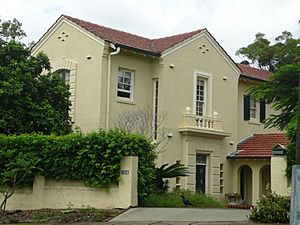Oogarding facts for kids
Quick facts for kids Oogarding |
|
|---|---|

Oogarding, 2009
|
|
| Location | 100 Simpsons Road, Bardon, City of Brisbane, Queensland, Australia |
| Design period | 1939 - 1945 (World War II) |
| Built | 1940 - 1965 |
| Built for | James Gervase (Gerb) Joyce and Mrs Edith Joyce |
| Architect | Mervyn Rylance |
| Architectural style(s) | Mediterranean Revival style |
| Official name: Oogarding | |
| Type | state heritage (built) |
| Designated | 23 June 2000 |
| Reference no. | 602074 |
| Significant period | 1940s, 1960s (fabric) 1940s (historical) |
| Significant components | other - residential: component, garage, residential accommodation - main house, furniture/fittings, basement / sub-floor, extension/s or addition/s, loggia/s, lead light/s, terracing |
| Builders | Jan Cupka |
| Lua error in Module:Location_map at line 420: attempt to index field 'wikibase' (a nil value). | |
Oogarding is a special old house in Bardon, Queensland, Australia. It was designed by a famous architect named Mervyn Rylance and built in 1940. This beautiful home is known for its unique Mediterranean Revival style. It is even listed on the Queensland Heritage Register because of its historical importance.
Contents
The Story of Oogarding
Oogarding is a large, two-story house built between 1940 and 1941. It was designed by architect Mervyn Rylance. The house stands out on a busy road in Bardon, surrounded by tall gum trees.
Who Built Oogarding?
In 1940, Mr. James Gervase (Gerb) Joyce and Mrs. Edith Joyce asked Mervyn Rylance to design their new home. The land for the house came from the Joyce family's own property. Gerb Joyce owned a well-known soft drink company called Helidon Spa. The Joyces named their new house Oogarding. This was an Aboriginal name for the spa that helped their business grow. The builder, Jan Cupka, likely suggested Rylance for the job.
The Mediterranean Style
Mervyn Rylance started his architecture business in Brisbane in 1933. He designed many homes, including some in the Mediterranean style. This style became popular in warmer parts of Australia. It was inspired by buildings found around the Mediterranean Sea. The style often used smooth walls, soft colors, and rounded arches. It aimed to feel like a sunny Mediterranean home. Rylance was one of the few architects in Brisbane who built pure Mediterranean-style houses.
Building and Changes
Jan Cupka built Oogarding. Mrs. Joyce remembered Rylance as a very dedicated architect. He visited the building site often during the nine months it took to build. He even helped create a special finish on the fireplace himself.
Later, in 1964, a new family room was added to the house. In 1965, a new garage, front terrace, and other garden changes were made. The kitchen was also updated. The Joyce family lived in Oogarding from when it was built until 1999.
What Oogarding Looks Like
Oogarding is a big, two-story house with a basement. Its walls are smooth and painted a creamy color. The roof has glazed terracotta tiles and decorative ends.
Special Entrance
The front door is a key feature. It has raised decorations that make it look like it's surrounded by large stones. The door itself has eight square panels. On each side of the door, there are four square windows. Above the door, a special stained-glass window (called a leadlight fanlight) shows the name of the house, "Oogarding."
Inside the House
When you enter, a hallway leads to the dining room, lounge room, and a terrace. These main rooms are large and spacious. The dining room and lounge room are connected by sliding wooden doors with arched tops. The lounge room has a fancy fireplace that looks like stone. Both the dining and lounge rooms have decorative plaster ceilings.
The terrace is a semi-enclosed space with three arched openings. The floors are made of a type of wood called red stringybark. All the wooden parts inside, like door frames and moldings, are made of silky oak wood.
Rooms for a Family
The house was designed for a family with a maid. There was a separate path connecting the main rooms to the kitchen and laundry. In the 1960s, the kitchen was moved to where the maid's room used to be. A rounded archway connects the utility areas to the garage, which can hold three cars.
Upstairs, there are four bedrooms, a bathroom, and a sleepout area. The main bedroom is large and has built-in closets. The bathroom is very detailed, with a special bath and a shower. It also has a unique sandblasted mirror designed by the architect.
Outside Details
On the outside, the main bedroom sticks out a little and is supported by decorative brackets called corbels. On the north side, French doors open to a small, semi-circular "Juliet" balcony. These doors have decorations similar to those around the front door. Most windows in the house are wooden and have outside wooden shutters.
Why Oogarding is Important
Oogarding was added to the Queensland Heritage Register on June 23, 2000. This means it is a historically important place that needs to be protected.
A Great Example of Style
Oogarding is a great example of a large Mediterranean-style house from the time between the two World Wars. It has many features of this style, like its unique shape, smooth walls, tiled roof, and special entrance. It also has arched loggias (covered walkways) and multi-paned windows with shutters.
Beautiful Design
The house is important because it is very beautiful and well-designed. It has careful details, high-quality interior fittings, and a lovely garden setting.
A Famous Architect's Work
Oogarding is also important because it is a well-preserved example of the work of Mervyn Rylance. He was a very important architect in Queensland during the interwar period. Oogarding is considered one of his best works and a key example of Mediterranean-style architecture in Queensland.

